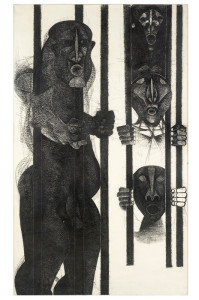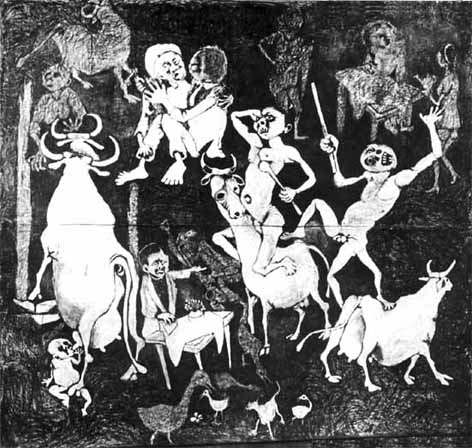
Dumile Feni, Gallery MOMO, Cape Town, until November 28, 2015.
The Prisoner, 1977-1991.
About:
Gallery MOMO Cape Town is delighted to be exhibiting works by the iconic South African artist, Dumile Feni (1942-1991). Feni captured the imagination of viewers through his depictions of the pain experienced by South Africans in the late 20th century. Feni is described as the ‘Goya of the townships’, alluding to his ability to depict the daily struggles experienced in South Africa during the Apartheid era. The exhibition will consist mainly of Dumile Feni’s sculptures, some of which have never been seen before.
Untitled, undated.
As Chabani Manganyi elaborates: “There was no way of stopping him once he had made up his mind. He overcame the most extraordinary social, political and personal obstacles to leave South Africa and the world with an outstanding artistic legacy” (Manganyi, 2012:49).
History, undated.
Interview with Sam Nhlengethwa
Renowned South African artist, Sam Nhlengethwa spoke to us about one of his icons.
When did you first come across Dumile’s work and what was your initial reaction to it?
I first came across Dumile’s work in art magazines. It was exciting to these art pieces. They were ink drawings with some incredible line work. I remember seeing a drawing called “Train Accident” about a severe train smash that killed a number of people. “Mother chopping wood” and “Ogre” were some other favourites of mine.
Silence, undated.
As an artist living in South Africa while artists such as Dumile and Gerard Sekoto were in exile, were you able to see works by these artists? Was their work accessible?
Much of Dumile’s work only became more accessible later on, however whilst studying at the Johannesburg Art Foundation, we as students were able to see some of his work. At this point in time, his sculptures had not yet emerged.
Why do you think Dumile’s art has captured the imagination of so many? Why has he become so highly regarded and left such a legacy?
Dumile captured the sufferings of the people, particularly in the townships, like no other artist. This is unlike the painter, Durant Sihlali who used painting to deal with these issues. Dumile’s line work was more visceral and dramatic than the tonality expressed in Durant’s paintings. Dumile came up with his own style of expression that was completely unique and authentic. He was a master of this technique that influenced many other artists including William Kentridge.
What was it like meeting Dumile in New York? What do you remember of this special encounter?
I couldn’t believe it. I was attending the Triangle Workshop in New York and he came to see me, the only artist from South Africa at the workshop. Dumile spent some time at the workshops seeing what all the artists were busy working on. After this visit he gave me his contact details and invited me to meet up with him. We went to explore the neighbourhood of Harlem. Dumile also bought two of my paintings and introduced me to a collector who also bought some of my work. He was intrigued to find out what South Africa was like at that time. So I told him the reality but clarified that “there was light at the end of the tunnel”. The terrible police incidents of 1976 and 1986 were over. This was in July 1991, and after our discussion Dumile felt that it was time to come home. I was therefore very shocked when I heard Dumile had passed away in November of 1991 whilst visiting his favourite record store, Tower Records. If he had come back we would have certainly provided him with a studio at the Bag Factory in Johannesburg.
Dumile also had a lot of respect for Bill Ainslie as did I. He was ‘out of this world’.
African Guernica, 1967.
Which Dumile Feni work is your favourite and why?
My favourite artwork is definitely “African Guernica”. Although it references Picasso’s masterpiece, Dumile has fashioned it in his own unique and expressive way. It really captures me. The fact that I used it in my Tribute piece to Dumile Feni makes it evident that it is my favourite work by him.
References
Manganyi, C. 2012. The beauty of the line: life and times of Dumile Feni. Johannesburg: KMM Review Publishing Company.
(text and courtesy Gallery MOMO, Cape Town)




